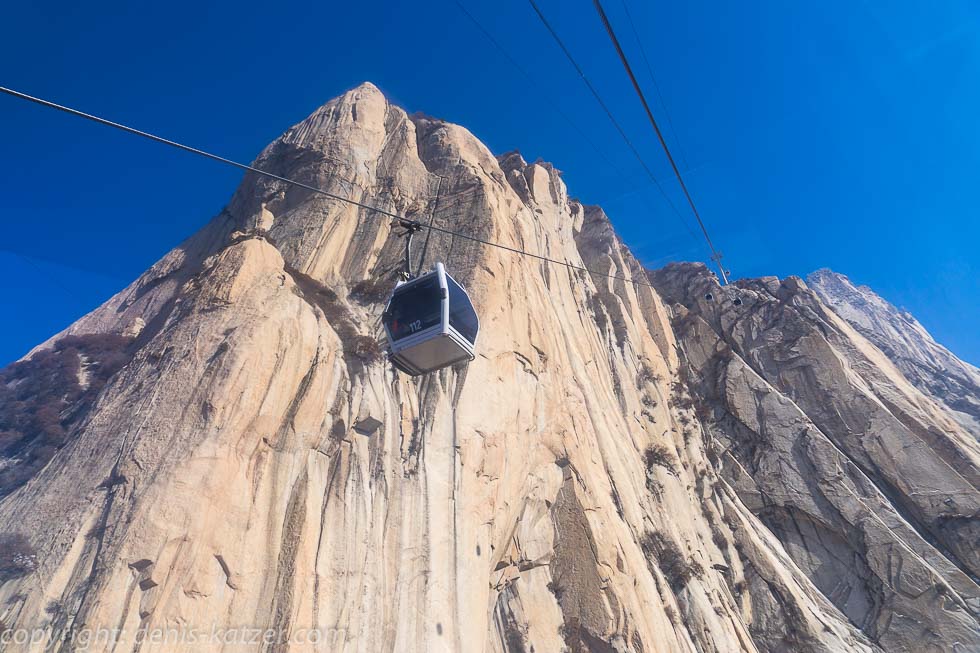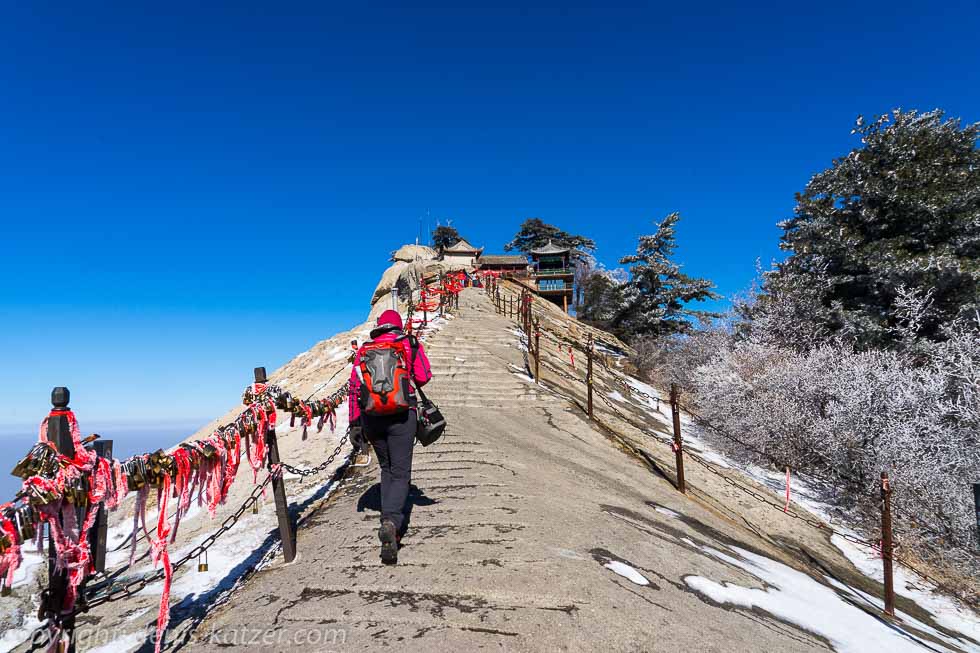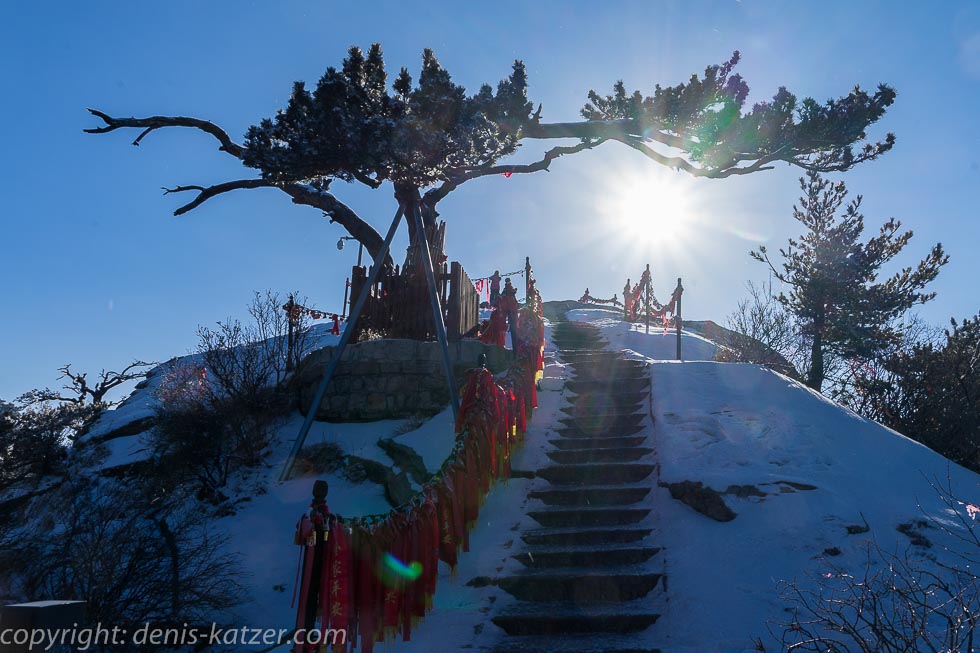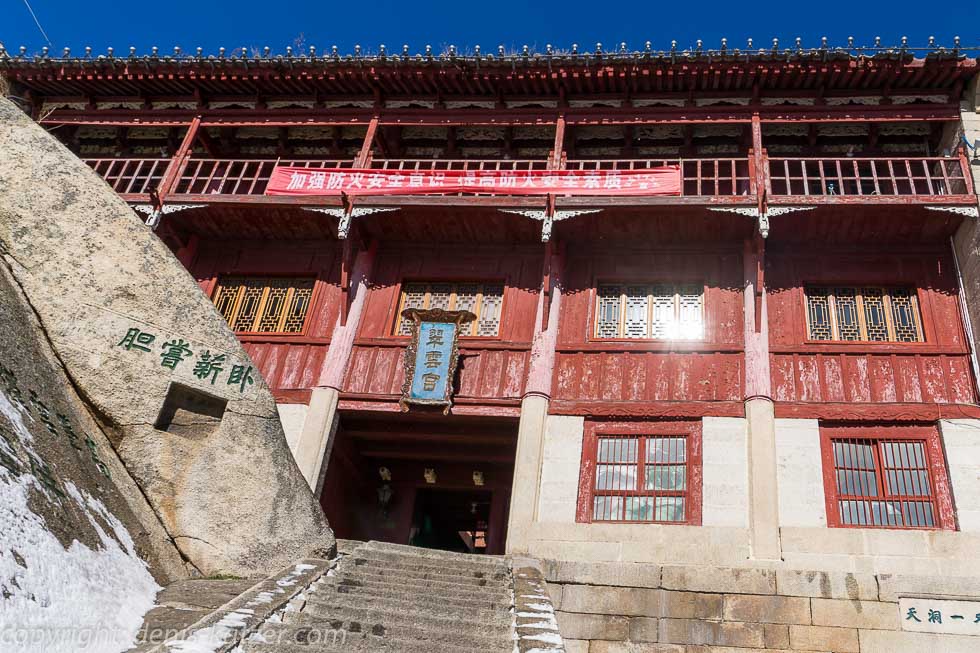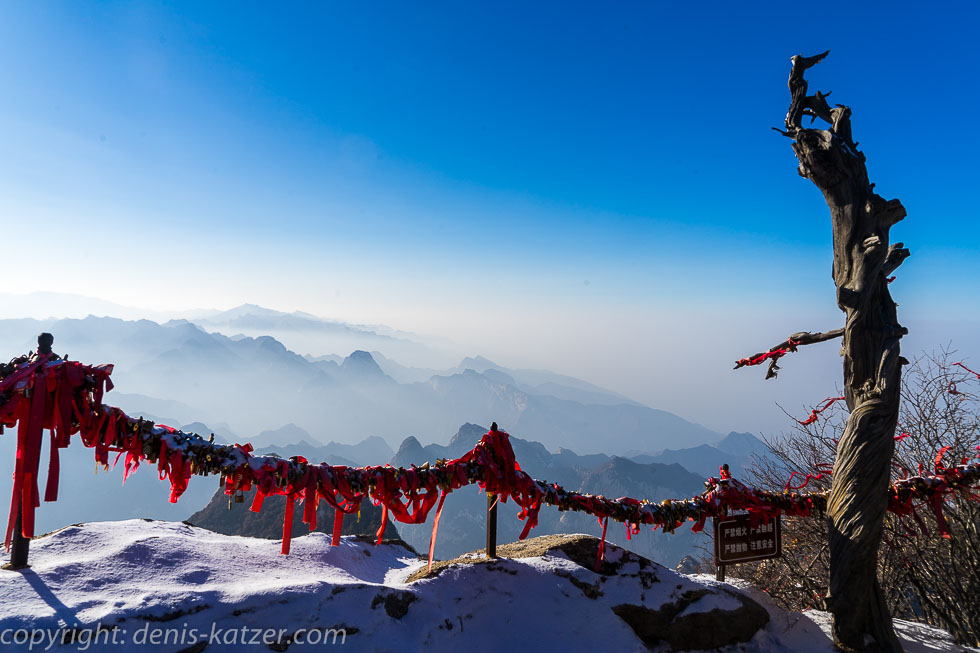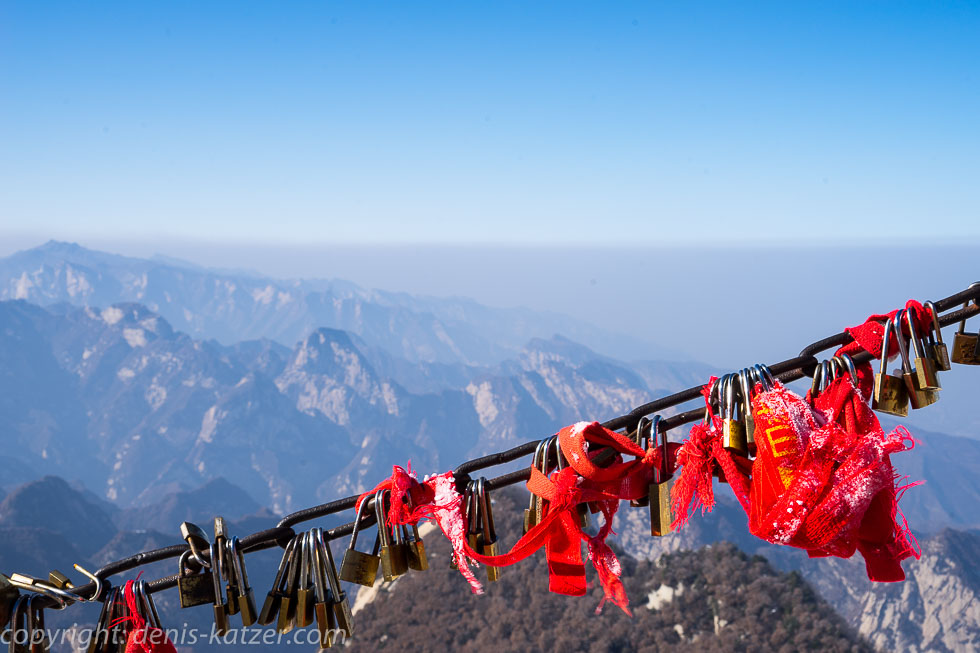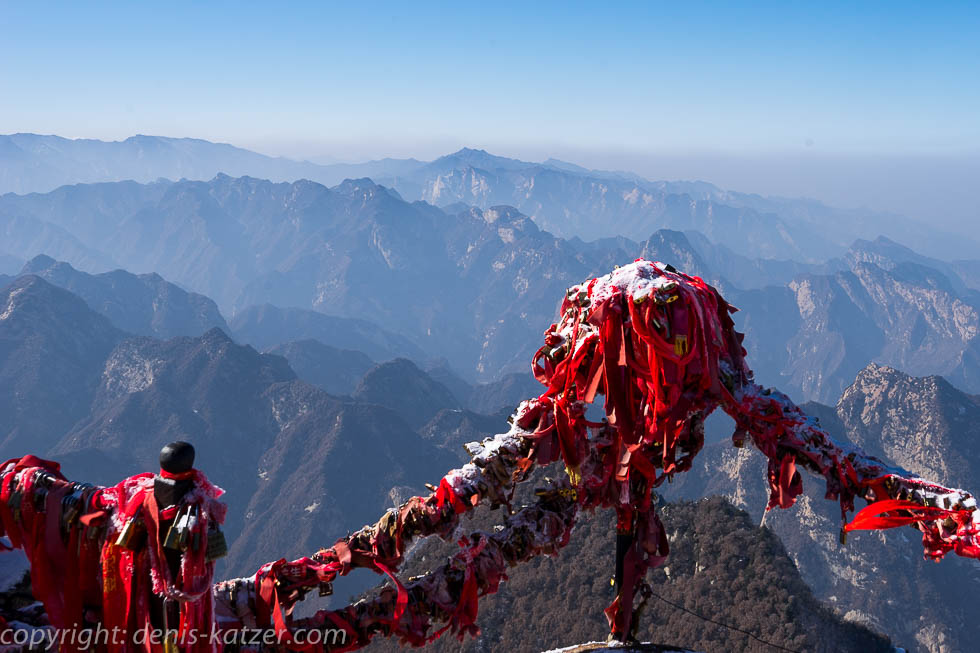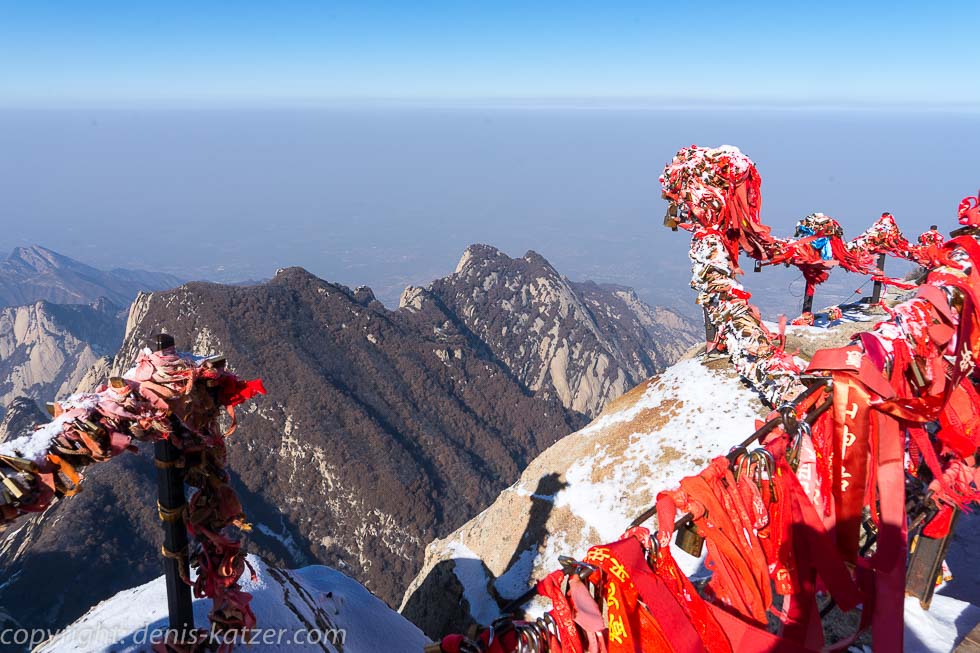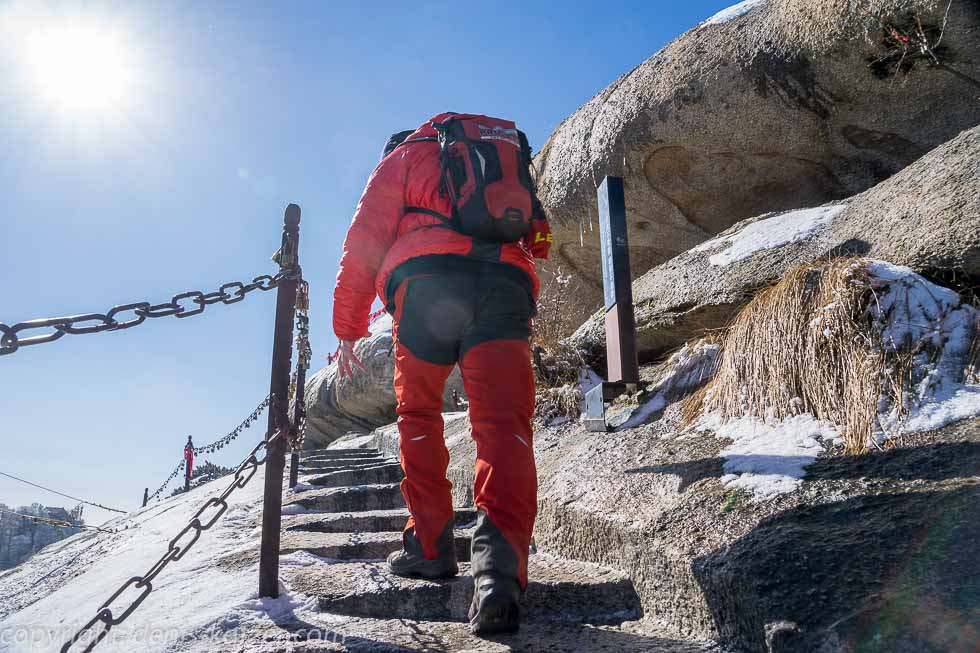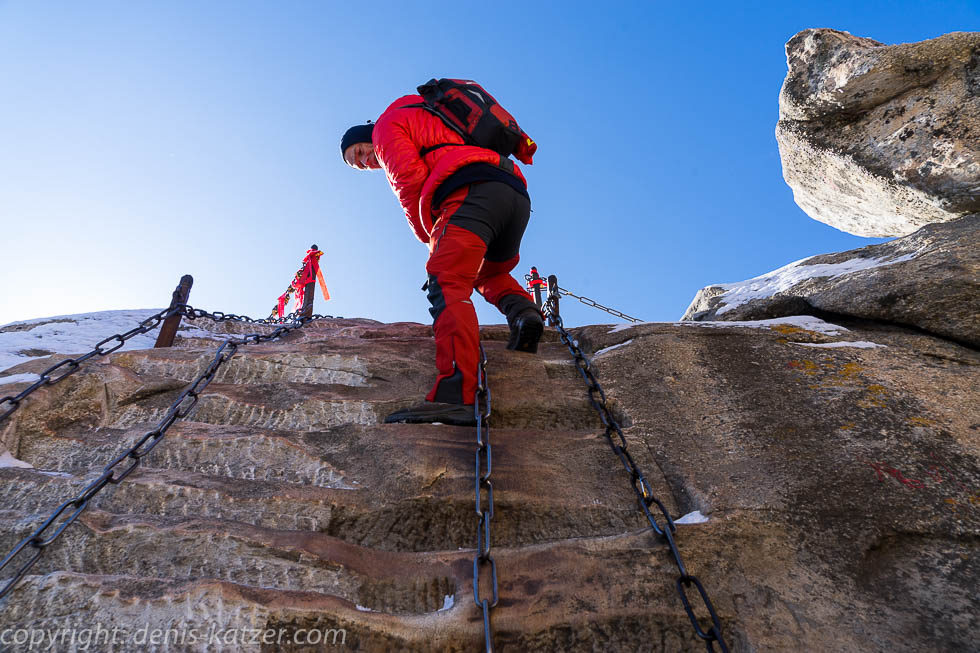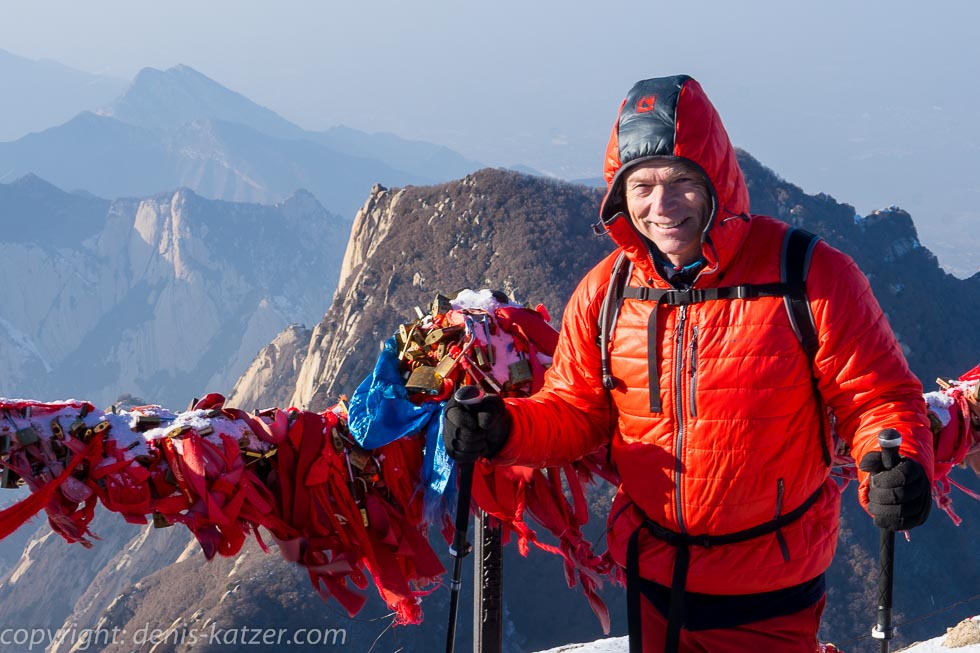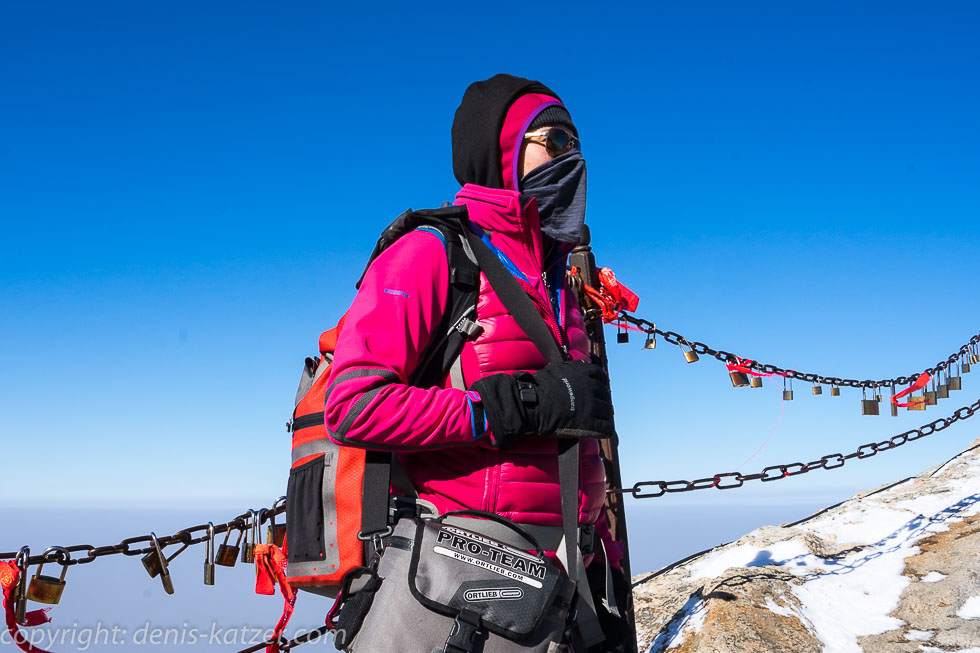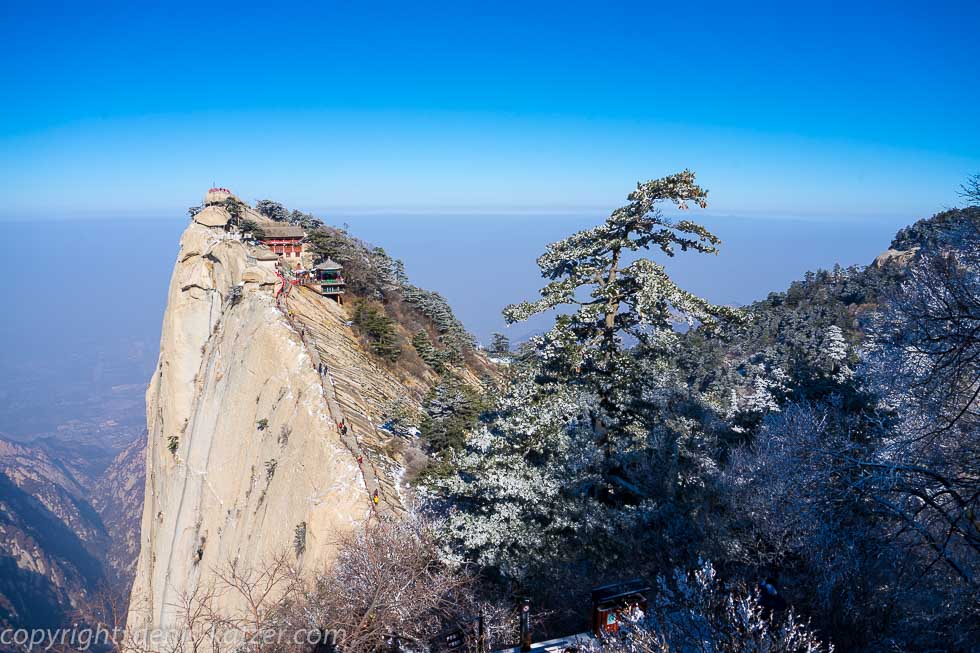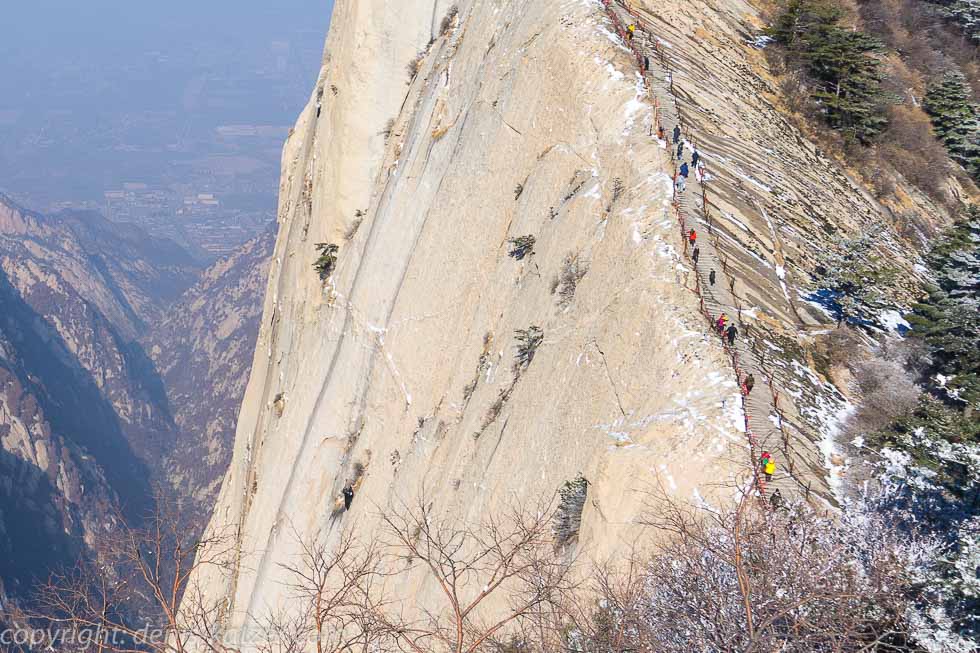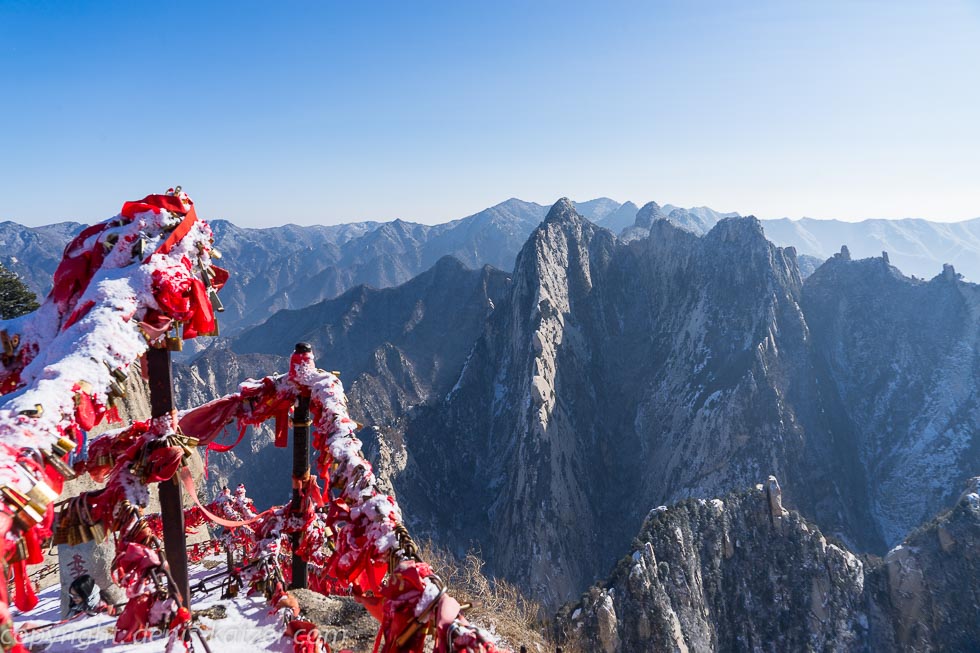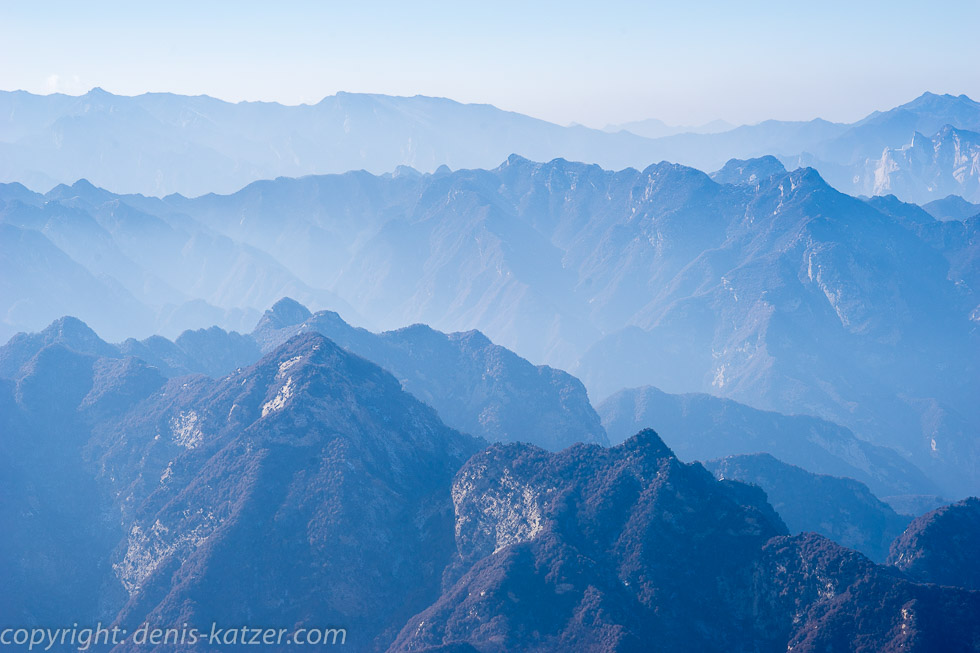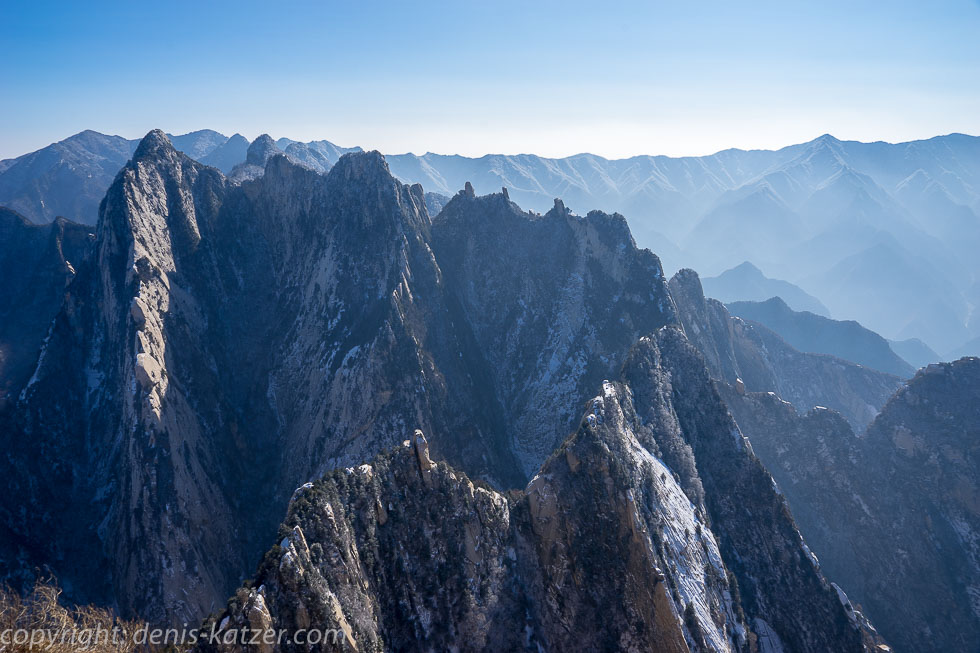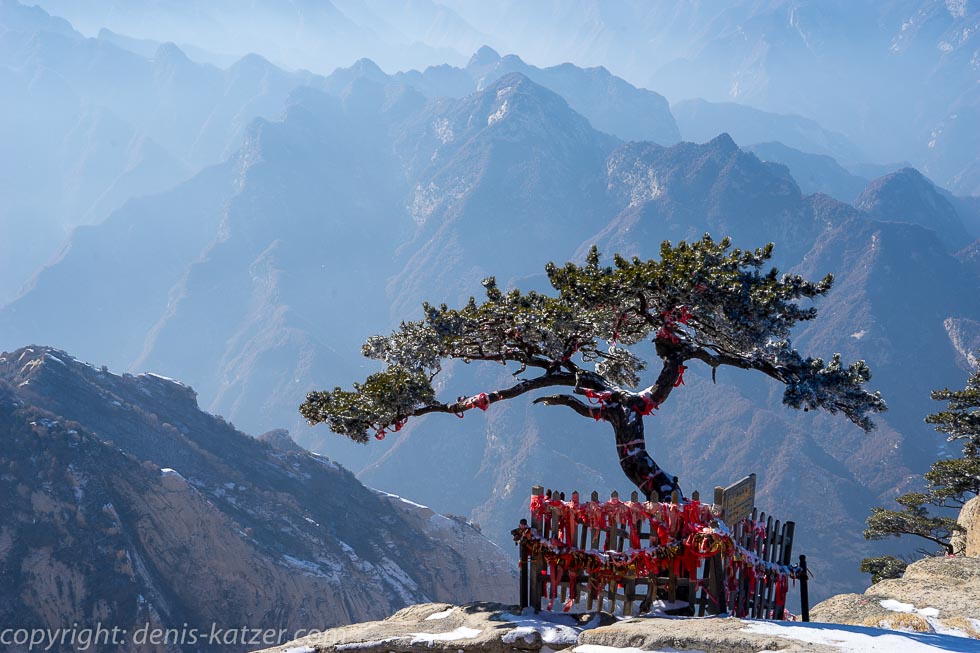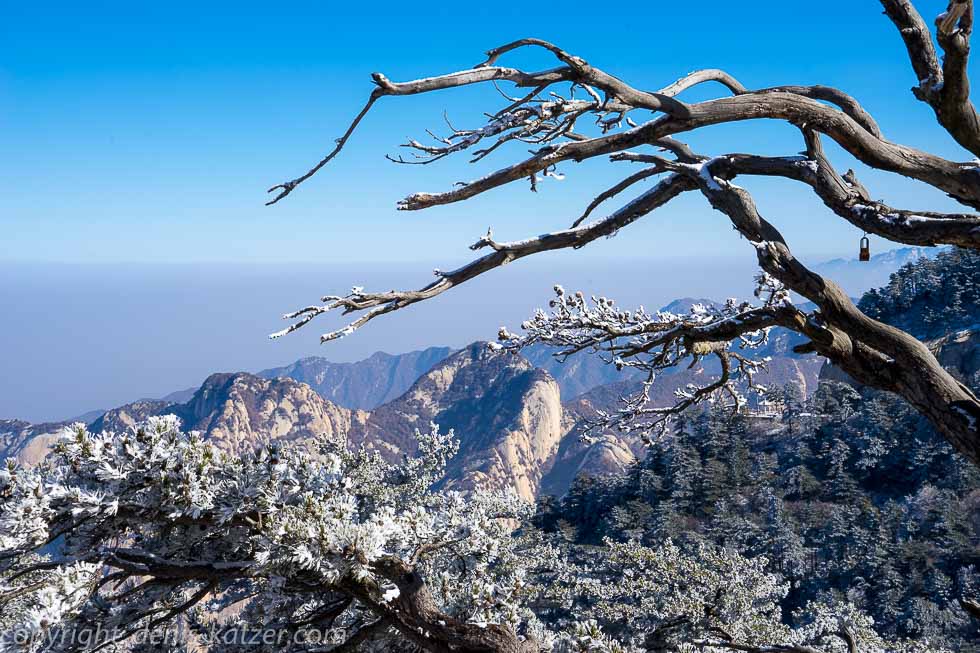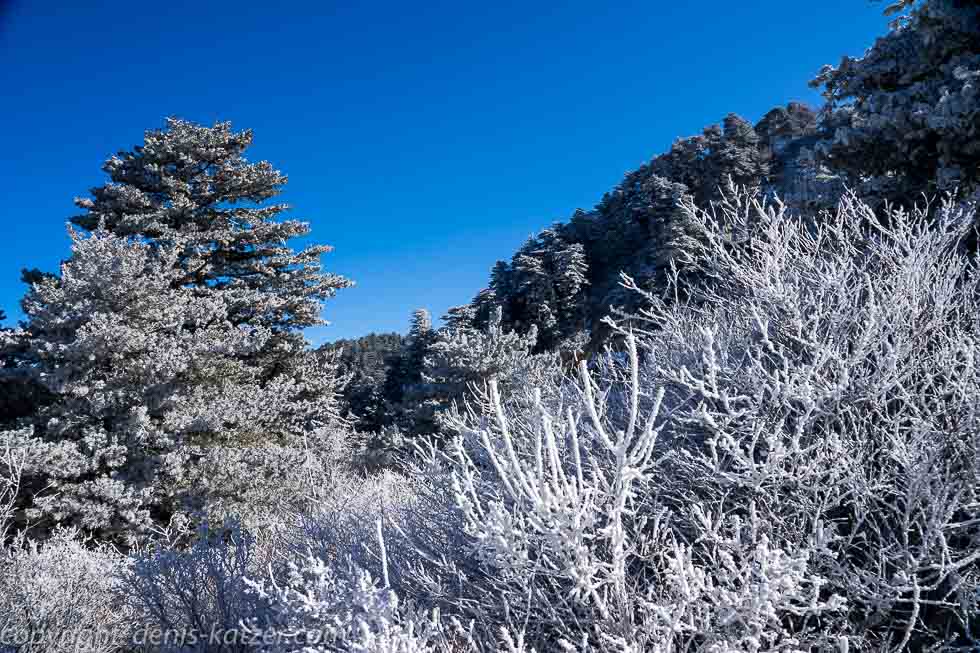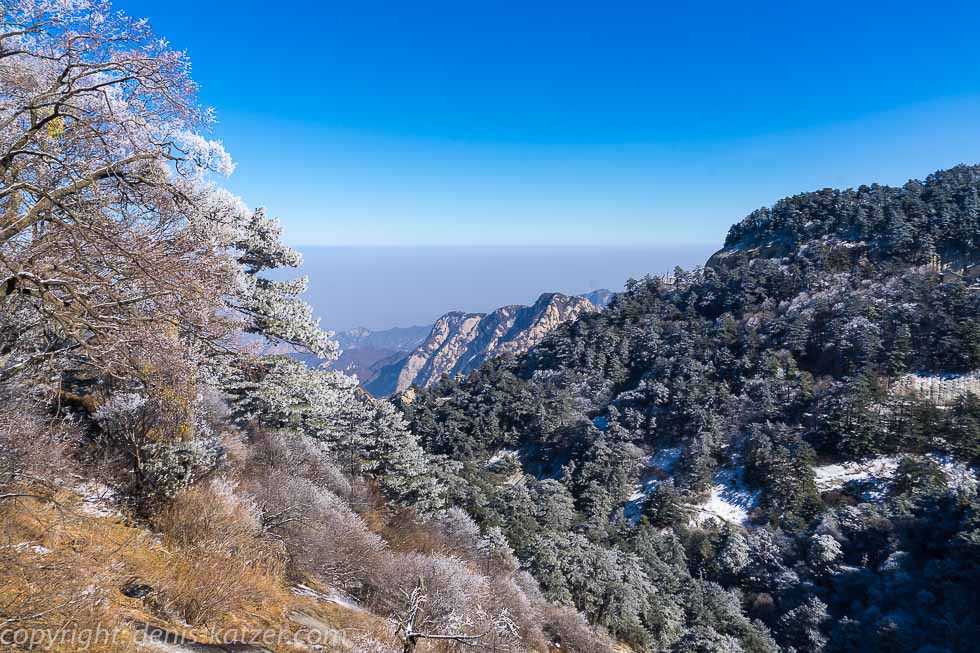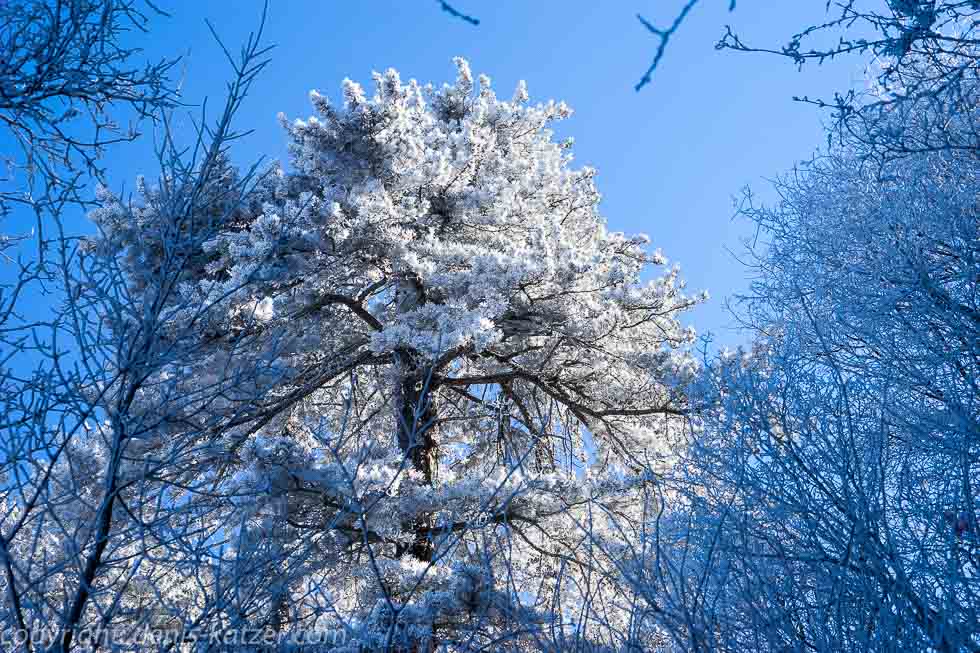
Breathtaking peaks
N 34°31'56.5'' E 110°04'31.9''
Date:
13.01.2016 until 16.01.2016
Day: 199 – 202
Country:
China
Province:
Shaanxi
Location:
Huayin
Latitude N:
34°31’56.5”
Longitude E:
110°04’31.9”
Daily kilometers:
60 (Bus)
Total kilometers:
11,696 km
Maximum height:
2.155 m
Total altitude meters:
13.929 m
Altitude meters for the day:
1.755
Sunrise:
07:46 am
Sunset:
17:48 to 17:51
Temperature day max:
2°C
Temperature day min:
minus 15°C
(Photos of the diary entry can be found at the end of the text).
Today we see the sun again for the first time in weeks. The Huashan mountain massif, whose peaks, up to 2,155 m high, are among the five sacred Daoist mountains in China, have today been cleared of the dense smog of the past few days. They rise majestically and respectfully into the grayish blue sky and form an insurmountable barrier to the city of Huayin in the south. As the air pollution in the valley is still considerable, we decided to take the new cable car up to the highest mountain, do a circular hike to the five peaks and then descend on the other side. We are excited because the Huashan Trail is one of the most dangerous hiking trails in the world, but is said to be breathtakingly beautiful because of its fabulous natural beauty, the captivating views over massive angular rocky peaks and the monasteries, pagodas, temples, bridges and gates.
After we have bought the tickets 280 Yuan (38,85 € for two persons) we sit with Chinese tourists in the bus that takes us to the valley station of the cable car. “I wonder how the bus gets to the top without snow chains,” I wonder, pointing to the increasingly frequent slabs of ice and snow-covered sections of the steep pass road. “You mean it could start to slip?” asks Tanja. “Of course,” I reply with a slightly queasy feeling in my stomach, because I know that no European safety regulations apply in this country. The bus stops at the side of the road just a few steep bends further on. While the guests remain seated, the driver actually puts on snow chains.
When we reach the cable car, we are amazed to find that we have to buy two more tickets. “But we’ve already paid the entrance fee,” complains Tanja. “Only the entrance fee and the bus ride, but not the cable car,” a young ticket inspector explains. So we pay another 240 yuan (€33.32) for the two of us. If we want to take the train back down to the valley, we have to buy tickets again at the top. We also learn that the bus ticket was also without a return journey. That means we have to fork out €106 just for the entrance fees to the mountain plus the journey there and back. “I’m surprised the Chinese don’t charge for breathing,” I say. “Ha, ha, ha, you can’t sell the bad air,” Tanja amuses herself.
We are the only guests far and wide to board one of the many eight-man gondolas. Considering that the mountain is closed in the main season when there are 50,000 visitors a day, it is a blessing to undertake such tours in winter. “Wow, look at that. It’s enough to make your jaw drop,” I exclaim enthusiastically, gazing at the panorama that can no longer be described in words. The mountain seemed inaccessible for ages. During the Tang Dynasty (618-907), Daoist monks, or those who perhaps wanted to become monks, carved step after step into the bare rock at absolute risk to make it accessible and to build meditation retreats at dizzying heights. Although I have already seen a lot in my life as a traveler and there is little that still blows me away, I can’t stop being amazed. Too excited to sit, I walk back and forth in our cabin. We gaze silently over a seemingly unreal high mountain range or into the infinite depths below us. Ancient steps and narrow paths covered in fresh snow wind their way through narrow, rugged gorges. The cable car ride alone is an experience of superlatives. It is a technical masterpiece by the Austrians to build such a construction in a rugged, perhaps thousand meter steep rock face. The higher we get, the clearer the air becomes. The smog cloud is at around 1,800 m. From then on, we finally breathe some wonderful mountain air again.
Once we reach the western summit, we climb up countless steps through a wonderful winter landscape. Trees and temples are covered in white powder snow. “Unbelievable. China really is a country of stark contrasts,” I say enthusiastically, breathing in and out deeply. We reach the monastery on the western summit. Not far from here, the monk Chen Tuan (871-989), who went down in history, experienced enlightenment in a cave. Here, too, there are only a few people at this time of year. We enjoy the tranquillity of the holy place which, according to descriptions, has long since lost its sacredness due to the huge crowds of Chinese tourists in summer. Then we make our way to the southern summit of Huashan. At around 2155 m, it is the highest mountain in the range. Once at the top, we inhale the far-reaching view, look down at the smog wall a few hundred meters below us and up into the clear blue sky above us. Here I realize again how beautiful the color blue is, the color of our planet, the oceans and deep clear mountain lakes. What energy it carries. What a purity. I stare into it, into the coolness it radiates, the harmony, the longing. It excites my imagination, makes me fall into another world. Perhaps into the world of the early Daoists who found their enlightenment up here? Only now do I feel how much I have missed her. Only now have I realized that this color has to do with health, because where the sky is so blue there is no man-made particulate matter. Sitting on the rock, we eat a banana, which starts to freeze stiff at minus 15 degrees.
Then, after four hours of walking up and down stairs, steps and icy paths, we start our way to the north summit and the descent. A route that was first used in the 3. and It was developed in the 4th century and is said to be very dangerous, as it leads over steep gradients and vertical precipices. The “Himmelsweg”, as part of the hiking trail we are about to walk on is called, clings to the angular rock face with planks only 30 cm wide in places. Just one misstep and you would plummet a thousand meters, were it not for the steel cables to which each of its courageous climbers must be secured. In some places, however, it goes so steeply up or down that the “path” is more comparable to a ladder. The steps and holes cut into the rock have been polished smooth by the weather. Every step must be right. In the most dangerous areas, iron chains are attached to which we can secure ourselves. I wouldn’t venture on such a tour in summer, as many ill-equipped tourists, wearing sandals or ballerinas, clamber up and down in masses to dizzying heights or depths. If just one of the upper ones were to lose its grip, there would be a terrible chain reaction, as it would drag the hikers below down with it. Many a visitor has lost their life or been seriously injured here. Today, however, it is cold and we are the only hikers on this path at this hour. But as it has just snowed, it could be slippery. “Let’s see if the daytime sun has melted away the snow,” I say as a small group of young Chinese people actually come towards us. “You can’t go any further. Absolutely impossible. Besides, the road is closed today,” they warn us in good English. Tanja can see the disappointment on my face. “Who knows what it’s good for? Let’s turn around and take the cable car back down to the valley. It was such an unforgettable day,” she says with a laugh…
The live coverage is supported by the companies Gesat GmbH: www.gesat.com and roda computer GmbH http://roda-computer.com/ The satellite telephone Explorer 300 from Gesat and the rugged notebook Pegasus RP9 from Roda are the pillars of the transmission.
